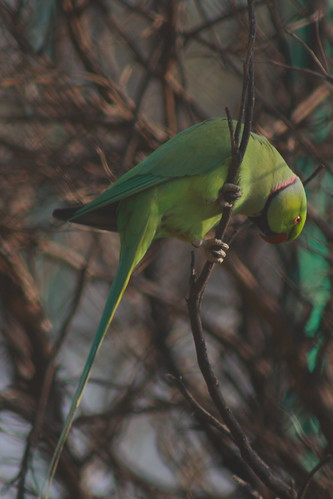

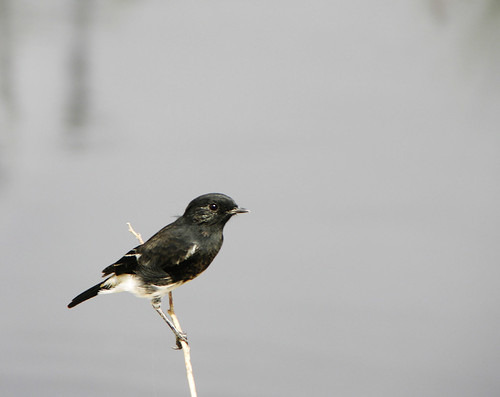
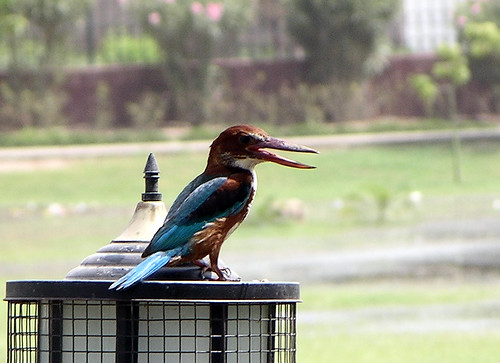
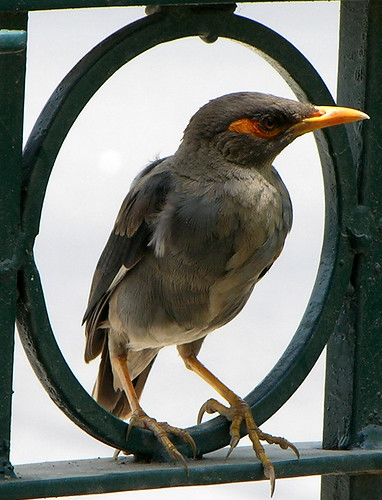
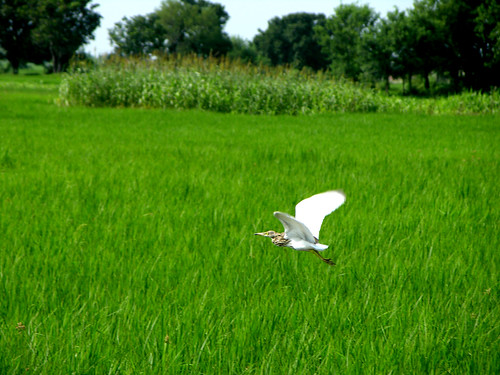
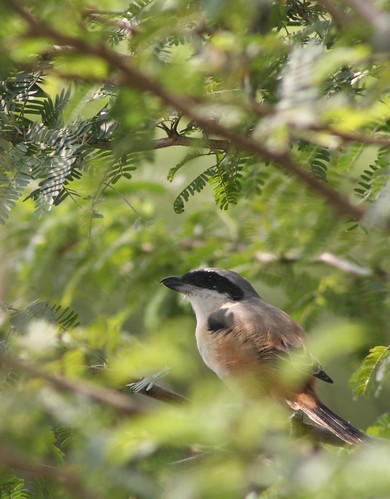
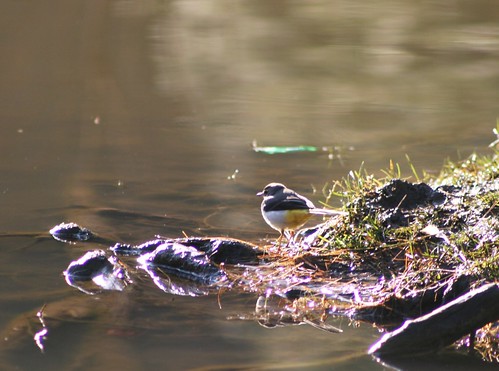

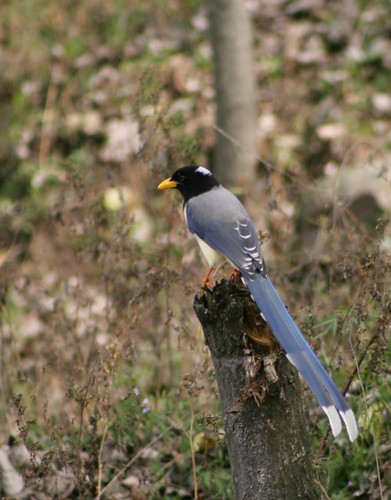

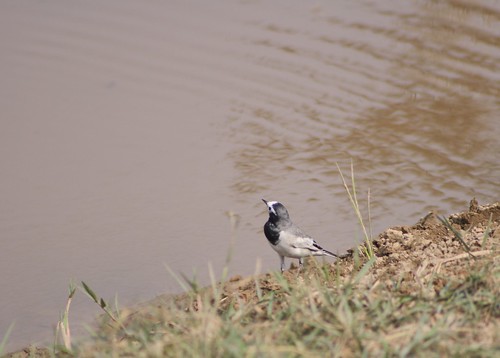


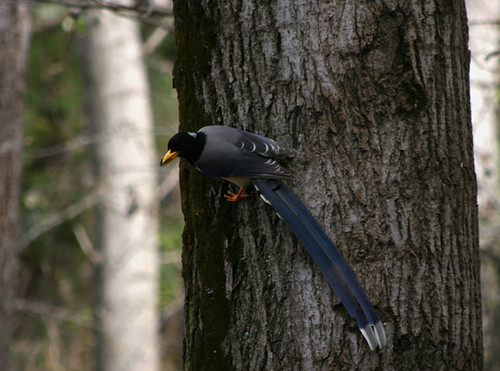
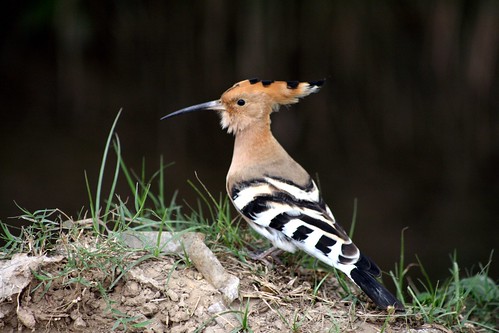
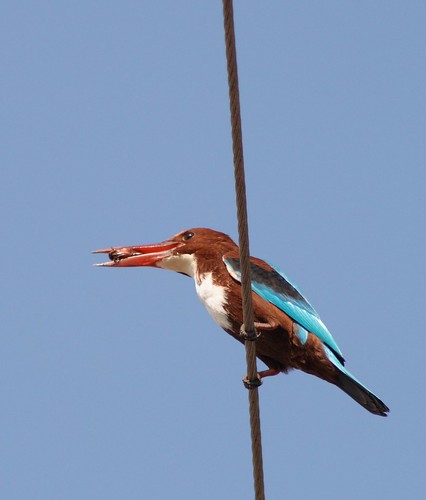

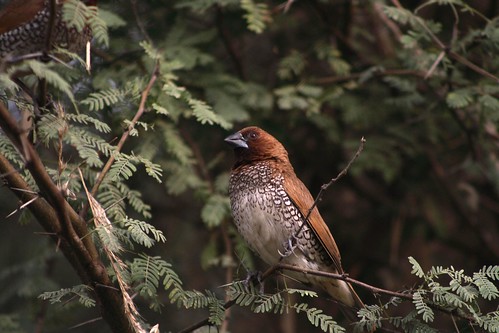
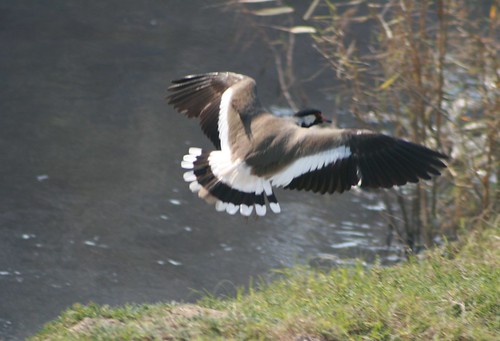
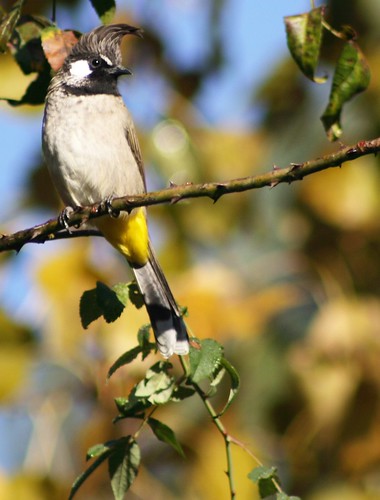
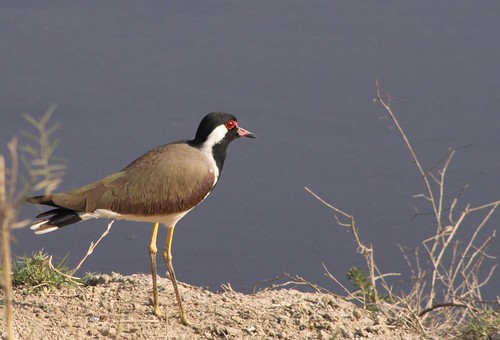
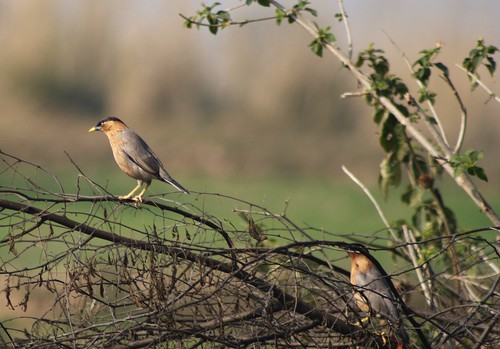
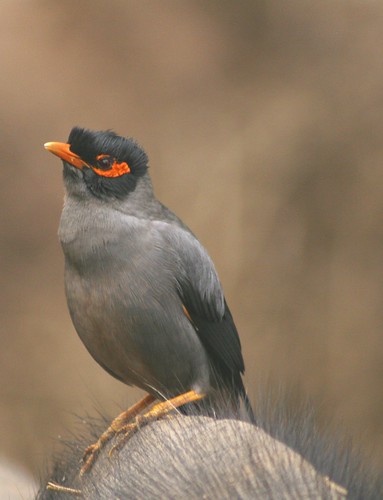
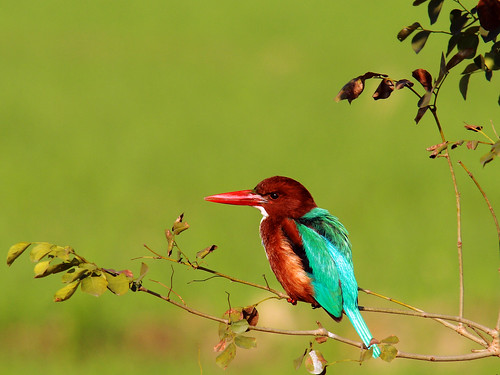


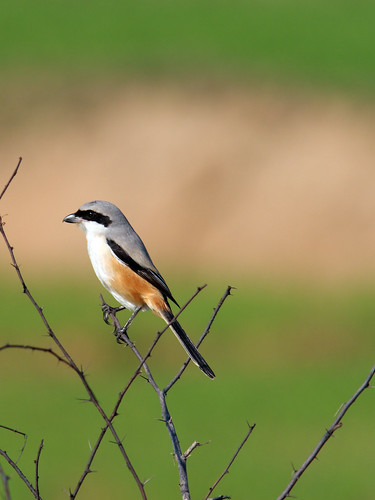
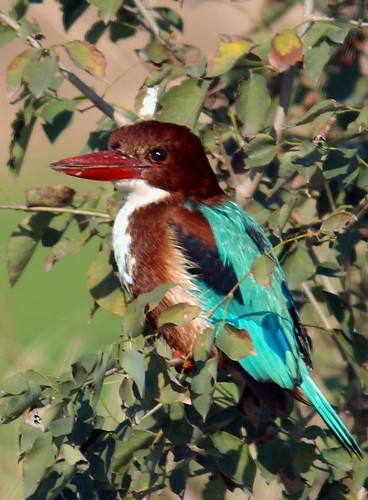

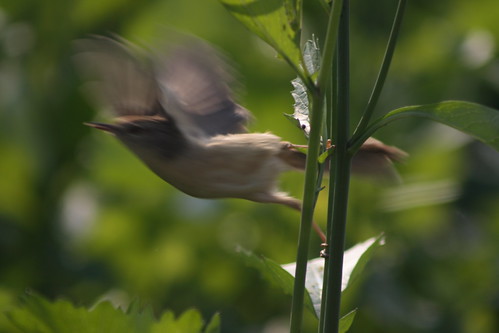
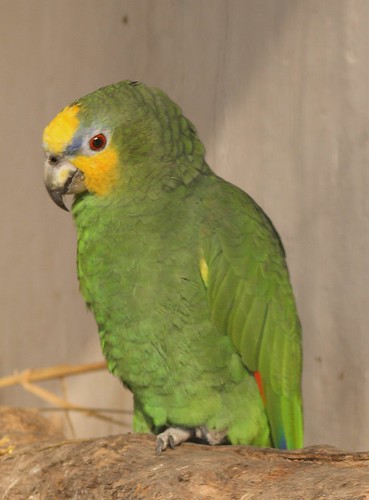
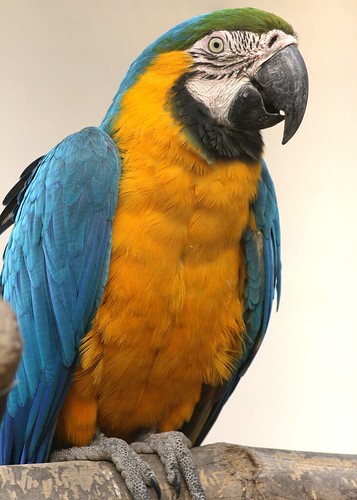
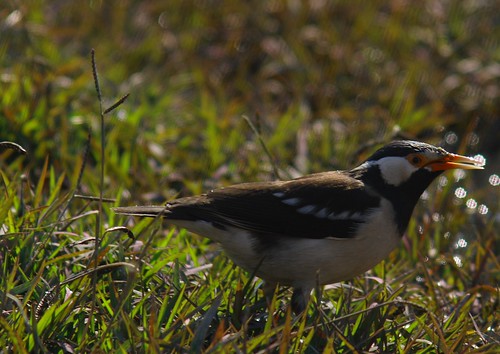
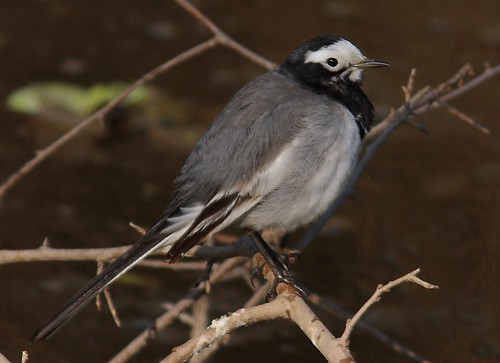
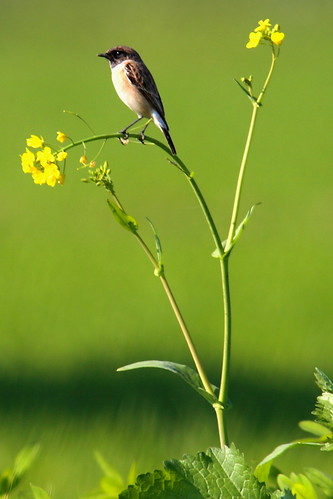
Nature Photography
Slideshow by M. Bukhari
Avian Photography
2118 views since March 22, 2009.
Get a link button for this slideshow »
Make and share your own slideshow »
1 of 36
Rose-Ringed Parakeet
The Rose-ringed Parakeet (Psittacula krameri), also known as the Ring-necked Parakeet, is a gregarious tropical parakeet species that is popular as a pet. Its scientific name commemorates the Austrian naturalist Wilhelm Heinrich Kramer.
This non-migrating species is one of few parrot species that have successfully adapted to living in 'disturbed habitats', and in that way withstood the onslaught of urbanisation and deforestation. In the wild, this is a noisy species with an unmistakable squawking call. Rose-ringed Parakeets are sexually dimorphic, and adult males sport black markings under their beaks and a dark band of colors around their necks.
Diet
In the wild, Rose-ringed Parakeets usually feed on buds, fruits, vegetables, nuts, berries and seeds.
Size
The Rose-ringed Parakeet is on average 40 cm (16 inches) long including the tail feathers. Its average single wing length is about 15?17.5 cm (6-7 inches). The tail accounts for a large portion of the length. The Indian Rose-ringed Parakeet, African Rose-ringed Parakeet, Abyssinian Rose-ringed Parakeet and Neumann's Rose-ringed Parakeet measure 42 cm, 40 cm, 40 cm and 43 cm long, respectively.
Scientific Classification:
Kingdom: Animalia
Phylum: Chordata
Class: Aves
Order: Psittaciformes
Family: Psittacidae
Genus: Psittacula
Species: P. krameri
Photo by NotMicroButSoft (CJ Restored Finally - Congrats)
2 of 36
Ulter Peak
Photos taken from the Roof of a hotel at Karimabad.
Photo by NotMicroButSoft (CJ Restored Finally - Congrats)
3 of 36
Loneliness
Noticed this Pide Bushchat while travelling along a storm drain on Jaranwala Road, near Faisalabad
Photo by NotMicroButSoft (CJ Restored Finally - Congrats)
4 of 36
Angry
White breasted KingFisher seems to be annoyed on something.
Shot taken in Jinnah Park, Faislaabad
Photo by NotMicroButSoft (CJ Restored Finally - Congrats)
5 of 36
Encircled
Bank Myna
Again in Jinnah Park Faislaabad
Photo by NotMicroButSoft (CJ Restored Finally - Congrats)
6 of 36
His ?th flight
Cattle Egret:
Photo Captured near Chak 42, On Lahore -- Shakargarh/Narang Road
Photo by NotMicroButSoft (CJ Restored Finally - Congrats)
7 of 36
Natural Hide-out
Rufous Backed Shrike (Lanius schach)
Found near Rangian Jangian - A small town near Sheikhupura. This beautiful bird is common and found throughout Pakistan.
This is the first shot with my new Canon 400D I am posting on flickr. Lens used: Cannon 75-300 mm.
Photo by NotMicroButSoft (CJ Restored Finally - Congrats)
8 of 36
Jheel Kinary
Citrine Vagtail (Motacilla citreola Found throughout Pakistan
Shot at Banjosa Lake, near Rawalakot, AJK.
Photo by NotMicroButSoft (CJ Restored Finally - Congrats)
10 of 36
Beauty of Nature
Yellow-billed Blue Magpie Urocissa flavirostris:
Photo by NotMicroButSoft (CJ Restored Finally - Congrats)
11 of 36
Shoot with Camera - Not with Gun
Yellow-billed Blue Magpie( Urocissa flavirostris): Some great views of these at middle altitudes in the forests of Kaghan valley, Neelum Valley (AJK), and in Galiyat Area/ Ayubia National Park.
Shot with Canon 400D: Lens: 75-300 mm at Rawalakot (AJK) Pakistan
Photo by NotMicroButSoft (CJ Restored Finally - Congrats)
12 of 36
White Wagtail
The White Wagtail (Motacilla alba) is a common resident bird of Pakistan. It is seen everywhere, especially in winter. It is a tiny bird with a long tail.
Identification: The White Wagtail?s length is 18 cm. Long-tailed, head and neck black and white, and largely white to largely black wing-coverts. Black-backed birds are possibly confusable with the White-browed Wagtails. Sexes are similar. Underparts white; female a little pale. In winter chin and throat white, blackish breast band, young pale, without black.
Habits: A typical Wagtail. Readily perches on telegraph wires, roofs of buildings and, less commonly, in trees. Runs with jerky head movements, constantly wagging tail; flight undulating.
Call: Call is a loud tslee-vit; song is a lively twittering and chattering with call-like notes.
Food: Insects.
Habit: Spends summers by streams and rivers in open country in hills and highlands; winters in open country near water body, wetland and grassland near water.
Breeding: April to early August. Nest is a cup made of dry grass, roots and leaves placed under a rock, bush or by a riverbank or in a hole in a wall or under eaves. Female lays 4-6 eggs; incubation 12-15 days; young fledge at 14-16 days.
Shot taken near Chak 50: on ShakarGarh/Narowal Road.
Photo by NotMicroButSoft (CJ Restored Finally - Congrats)
13 of 36
Funny: Isn't It?
Shot taken in Rana Town, near Lahore
Notice the Black Drongo landing on the back of the goat.
Photo by NotMicroButSoft (CJ Restored Finally - Congrats)
14 of 36
Back-Riding
Black Drongo
A slim, agile, glossy black bird with a long, deeply forked tail in the shepherd country. often you will find it enjoying the ride of a buffalo, sheep or a cow. It sits on the back of these living vehicles and keeps a strict vigil on the insects disturbed by the movement of the cattle through the grass.
Favorite Diet
Grasshoppers and other insects living in grass are its favourite. The moment disturbed insects come out, they are pounced upon and carried off, held under feet...torn and eaten. It is very beneficial to agriculture as it destroys a large variety of insects harmful to the crops. It?s rather interesting that when the other species run away from the jungle fires, a large number of Drongos are attracted towards it because of easy availability of food.
Apart from the insects, drongos love to eat small birds and sometimes taste flower nectar. The bird is found all over the Indian subcontinent, Bangladesh, Myanmar, Sri Lanka and Pakistan. Both the parents share domestic duties and fiercely protect their nests. Normally three to five whitish eggs with brownish red spots are laid.
Found it Riding on back of a Goat: Photo taken in Rana Town, near Lahore.
Photo by NotMicroButSoft (CJ Restored Finally - Congrats)
15 of 36
Bird-Watch
Yellow-Billed Blue Magpie
Captured at Rawlakot-Khaigala Byepass Road, Rawlakot, AJK
Photo by NotMicroButSoft (CJ Restored Finally - Congrats)
16 of 36
Alone in Dark
HOOPOE ( Upopa epops)
These birds are very colorful with a pair of smart wings with black and white zebra markings. The Hoopoe eats insects that live in the ground and that is why it keeps walking quickly digging the earth with its long curved beak. The Hoopoe has a pretty crest on its head, which is usually kept neatly folded back. They male digs out a nest in tree cavities. The female lays 6-7 eggs which she alone incubates. Both parents feed their offspring in the following manner. One nestling awaits the adult?s arrival at the entrance hole and as soon as it receives its ration, the one behind pushes to the front, till all are fed.
DIET: Insects, larvae, cattle droppings, locusts, spiders, and fly.
Shot taken at Chak 50, on Shakargarh-Narowal Road near Rana Town.
Photo by NotMicroButSoft (CJ Restored Finally - Congrats)
17 of 36
Its Lunch time
White Breasted Kingfisher ( Halcyon Smyrnensis)
This is one of the birds that can never fail to catch your attention. A brilliant turquoise blue with deep chocolate-brown head, neck and under parts, a long bright red ?kingfisher-like? bill and white front catches immediate attention. It?s size of a pigeon but appears much smaller due to the way it sits. Both the sexes are alike and pairs can be seen near ponds, jheels (lakes), dense jungles etc. In fact the bird can be seen both near and away from water bodies.
The bird is found in plains and lower hills all over India, Pakistan, Sri Lanka, Myanmar and Bangladesh. Four races have been identified according to colour and size differentiation. It is very fond of fish, tadpoles, grasshoppers, lizards and insects. Like pied kingfisher, white breasted kingfisher also observes its prey from the superior position and the moment its within reach, a flash of lightening it catches it.
Like his cousin, the white breasted kingfisher enjoys his food again at a perched place. The nesting season is from March to July. The nest is a horizontal tunnel like structure dug in a precipitous mud-bank of the stream, where four to seven white spherical eggs are laid.
In this pictrure (taken in Faisalabad, Pakistan), the King fisher is enjoying its lunch of a Cockroache.
Photo by NotMicroButSoft (CJ Restored Finally - Congrats)
18 of 36
Indian Roller
Indian Roller or Blue Jay (Coracias Benghalensis)
This delightful bird is a collage of colours. The bird is of a striking blue color with a rufous brown breast and a pail blue abdomen and under tail. But the magnificence of its colours is best exhibited in flight when the dark and light portions show up as brilliant bands on the wings.
This bird is dear to the human inhabitants of its habitat because it has served them well as an effective pest controller, ridding the agricultural fields of a variety of injurious insects which form a part of its diet other than frogs and lizards.
It is found in the subcontinent from the foothills of the Himalayas down to the south in Sri Lanka and from Pakistan to Myanmar in the open country and light deciduous forest patches. This roller makes a variety of loud jarring noises and indulges in a spectacular courtship display which involves a lot of acrobatic stunts like nose-diving and somersaulting in air.
Photo by NotMicroButSoft (CJ Restored Finally - Congrats)
19 of 36
Ambushed
Spotted Munia ( Lonchura punctulata )
Field Identification : Sexes alike. Adult has chestnut-brown face, throat and upper breast, whitish under parts boldly scaled with black, olive-brown upper parts, and olive-yellow to rufous-orange on uppertail-coverts and edges of tail.
Size and Form : 11-12 cm.; swiftlet.
Status : Resident.
Distribution : Most of Pakistan
Habitat : Cultivation, gardens, secondary forest, bush covered hill-sides.
Food : Small berries and seeds.
Breeding : Throughout the year.
Photo taken in village 50-Chak, on Shakargarh Road, near Lahore.
Photo by NotMicroButSoft (CJ Restored Finally - Congrats)
20 of 36
Landing
Red-wattled Lapwing - ( Vanellus indicus )
This is a bird, which had learnt to coexist with humans. It is one of the most common birds found throughout India, Pakistan, and Sri Lanka up to a height of 2000 metres above mean sea level.
Easy to identify it is a fairly a large wading bird of about 25 - 30 cms tall. It is one of the most colourful of the lapwings found in the country. It's metallic brown above and white below. Its breast, head, and neck are black. It has a fleshy red wattle in front of each eye. A broad white band runs from behind the eyes down the sides of the neck to meet the white under parts. It is difficult to differentiate the sexes. The males are slightly larger than the females.
It is usually found in pairs in open countryside near a water source. It may be away from the water source during foraging. It haunts ploughed fields and waterways in agricultural fields. It makes a familiar did-he-do-it call repeatedly on sighting some intruder in its territory.
It feeds mainly to insects, grubs and molluscs. Lapwings are a farmer's friend. It is one of the most vigilant birds also. Its agility to detect the intruders fast could be of great boon to farmers too, provided the bird nests or roosts nearby.
It is classified as least concern by the IUCN Red List of Threatened Species, the world's most comprehensive inventory of the global conservation status of plant and animal species maintained by the International Union for Conservation of Nature and Natural Resources.
Photo by NotMicroButSoft (CJ Restored Finally - Congrats)
21 of 36
Bulbul-e-Hazaar Dastaan
Translation: The bird of 1000 stories
White-eared Bulbul
(Pycnonotus leucotis)
The White-eared Bulbul (Pycnonotus leucotis), is found mostly in the desert-dry lowlands from Afghanistan, Pakistan, Iraq, Iran, Bahrain, and as far east as the northern parts of India.
This bulbul has a medium gray body, jet black head, subtle rounded black crest and a distinct white patch over the ear coverts, hence the name. Feet and legs are mottled dark gray/brown
This species is very similar in appearance to the Himalayan White-cheeked Bulbul Pycnonotus leucogenys but smaller and uncrested and with a larger white cheek patch. It has a pale bare eye-ring. The vent is orange yellow. Sexes are alike.
It is found in scrub forest and gardenland. Usually seen in pairs or small groups. It feeds on fruits and insects, and breeds in March-June.
Shot taken at Banjosa Lake, near Rawalakot, AJK, District Poonch.
Photo by NotMicroButSoft (CJ Restored Finally - Congrats)
22 of 36
Red-wattled Lapwing (Tutoli in Punjabi)
Red-wattled Lapwing - ( Vanellus indicus )
This is a bird, which had learnt to coexist with humans. It is one of the most common birds found throughout India, Pakistan, and Sri Lanka up to a height of 2000 metres above mean sea level.
Easy to identify it is a fairly a large wading bird of about 25 - 30 cms tall. It is one of the most colourful of the lapwings found in the country. It's metallic brown above and white below. Its breast, head, and neck are black. It has a fleshy red wattle in front of each eye. A broad white band runs from behind the eyes down the sides of the neck to meet the white under parts. It is difficult to differentiate the sexes. The males are slightly larger than the females.
It is usually found in pairs in open countryside near a water source. It may be away from the water source during foraging. It haunts ploughed fields and waterways in agricultural fields. It makes a familiar did-he-do-it call repeatedly on sighting some intruder in its territory.
It feeds mainly to insects, grubs and molluscs. Lapwings are a farmer's friend. It is one of the most vigilant birds also. Its agility to detect the intruders fast could be of great boon to farmers too, provided the bird nests or roosts nearby.
It is classified as least concern by the IUCN Red List of Threatened Species, the world's most comprehensive inventory of the global conservation status of plant and animal species maintained by the International Union for Conservation of Nature and Natural Resources.
Photo by NotMicroButSoft (CJ Restored Finally - Congrats)
23 of 36
Brahminy Myna
The Brahminy Mynah or Brahminy Starling , (Sturnus pagodarum), is a member of the starling family of birds. It is a resident breeder in eastern Afghanistan, Nepal, India and Sri Lanka. It is also found in Pakistan (Punjab and Palas Valley). The bird is popularly known as a mynah (Salim Ali describes it as a "typical myna" in its behaviour and appearance, but recent taxonomic classification favours the Starling characterization.
The Brahminy Mynah builds a nest in hole. The normal clutch is 3-4 eggs. The adults of these 21cm long birds have grey upperparts and reddish-orange underparts and black wing quills. The head has a black crown, nape and crest, and the underneath of the tail is white. The bill and the strong legs are bright yellow, and there are yellow wattles on the gape. The recumbent crest may be fluffed up. Young birds have crestless sooty brown head and dull general coloration.
The sexes are similar, but juveniles are duller, lack the crest, and have a brown crown. Like most starlings, the Brahminy Starling is fairly omnivorous, eating fruit and insects.
Photo shot along bank of Upper Jhelum Canal near Khardi Sharif (Mipur AK).
Photo by NotMicroButSoft (CJ Restored Finally - Congrats)
24 of 36
Bank Myna (Acridotheres ginginianus)
It is a chordate, or more specifically a bird, in the Sturnidae family, commonly known (its common name) as the Bank Myna in English.
Species Authority: The species authority, or the name(s) of scientist(s) or person(s) who first described Acridotheres ginginianus is (Latham, 1790)
Country Distribution: Acridotheres ginginianus is found in the following countries:
Bangladesh, Bhutan, India, Jordan [int], Kuwait [int], Myanmar, Nepal, Pakistan, Taiwan, Province of China
Range: This species has a large range, with an estimated global Extent of Occurrence of 1,000,000-10,000,000 km. The global population size has not been quantified, but it is believed to be large as the species is described as 'common' in at least parts of its range (Feare et al. 1998). Global population trends have not been quantified, but the species is not believed to approach the thresholds for the population decline criterion of the IUCN Red List (i.e. declining more than 30% in ten years or three generations). For these reasons, the species is evaluated as Least Concern. (IUCN Red List).
CONSERVATION STATUS
Red List Category & Criteria: Listed as LC ver 3.1 (2001) (IUCN Red List).
Year Assessed: Acridotheres ginginianus's status was assessed in 2004 (IUCN Red List).
Assessor: Acridotheres ginginianus's Red List status was evaluated by BirdLife International (IUCN Red List).
Red List Evaluator: The Red List Evaluator for Acridotheres ginginianusis listed by IUCN as Ekstrom, J. & Butchart, S. (BirdLife International Red List Authority) (IUCN Red List).
Red List History: Acridotheres ginginianus was listed on the IUCN Red List of Threatened Species in 1988 (IUCN Red List).
Kingdom: ANIMALIA
Phylum: CHORDATA
Class: AVES
Order: PASSERIFORMES
Family: STURNIDAE
Common Name/s BANK MYNA (E)
Species Authority (Latham, 1790)
Photo shot at Faizabad village near Sharqpur - 50 km away from Lahore.
Photo by NotMicroButSoft (CJ Restored Finally - Congrats)
25 of 36
The Most Expensive Photo on Flickr
The White-throated Kingfisher, Halcyon smyrnensis also known as White-breasted Kingfisher or Smyrna Kingfisher is a tree kingfisher which is widely distributed in plains and lower hills all over India, Pakistan, Sri Lanka, Myanmar and Bangladesh. Four races have been identified according to colour and size differentiation.
The adult has a bright blue back, wings and tail. Its head, shoulders, flanks and lower belly are chestnut, and the throat and breast are white. The flight of the White-throated Kingfisher is rapid and direct, the short rounded wings whirring. The large bill and legs are bright red. In flight, large white patches are visible on the blue and black wings. Sexes are similar, but juveniles are a duller version of the adult. The call of this noisy kingfisher is a chuckling chake-ake-ake-ake-ake.
White-throated Kingfisher is a common species of a variety of habitats with some trees, and its range is expanding. It perches conspicuously on wires or other exposed perches within its territory, and is a frequent sight in south Asia.
The nest is a 50cm tunnel in an earth bank. A single clutch of 4-7 round white eggs is typical.
Diet
This species mainly hunts large insects, rodents, snakes, fish and frogs. It is reputed to eat tired migratory passerine birds like Chiffchaffs where the opportunity arises. Like pied kingfisher, white breasted kingfisher also observes its prey from the superior position and the moment its within reach, a flash of lightening it catches it.
Scientific Classification
Kingdom:Animalia
Phylum:Chordata
Class:Aves
Order:Coraciiformes
Family:Halcyonidae
Genus:Halcyon
Species:H. smyrnensis
PHOTO TAKEN NEAR GUJRANWALA. This is the most expensive picture on flickr. It costed me and my friend GR Moughal, one 400D SLR, a 20D SLR, one 300 mm L-Series Fixed Tele, a 75-300 mm tele zoom, two memory cards, 15,000 cash, plus one LCD, and USB to get this photo. All these things were robbed by two robbers on the same day when we were about to return after a very productive day in terms of birds photography.
Photo by NotMicroButSoft (CJ Restored Finally - Congrats)
26 of 36
One of the Most Expensive Photos on Flickr
The Indian Robin (Saxicoloides fulicata), is a small passerine bird that was formerly classed as a member of the thrush family Turdidae, but is now more generally considered to be an Old World flycatcher, family Muscicapidae. It, and similar small species, are often called chats.
The Indian Robin is an insectivorous species which is a resident breeder in Pakistan, India and Sri Lanka. It is found in scrub jungle and other open habitats including around habitation. It nests in a hole in a wall, tree-stump or bank, laying 2-3 creamy white eggs on a pad of grass lined with feathers or hair. Only the female incubates the eggs.
This is a common and tame bird. It is terrestrial, hopping along the ground with cocked tail. The male sings a few melodic notes during courtship.
Size: This species is 19cm long, including the long cocked tail. It is similar in shape to the smaller European Robin, but is longer-tailed.
Field Identification: Graduated black tail, which is frequently held cocked and reddish vent and undertail-coverts. Adult male has glossy black under parts and white shoulder patch. Female has greyish-brown upper parts and purer grey under parts and lacks white shoulder patch.
Habitat : Dry, stony areas with sparse scrub, arid stony ridges, cultivation, deserted buildings.
Food: Insects.
Breeding: December-September
Scientific classification:
Kingdom:Animalia
Phylum:Chordata
Class:Aves
Order:Passeriformes
Family:Muscicapidae
Genus:Saxicoloides Lesson, 1832
Species:S. fulicata
PHOTO TAKEN AT GUJRANWALA on the same day, when my camera was robbed by two local robbers in a suburban village.
Photo by NotMicroButSoft (CJ Restored Finally - Congrats)
27 of 36
Flickr's Most Expensive Pictures Series (continued)
Kingfiser on a dry tree's top. This one was also taken on the day of robbery.
Shot in a village on Gujranwala-Hafizabad road.
Photo by NotMicroButSoft (CJ Restored Finally - Congrats)
28 of 36
Flickr's Most Expensive Photo Series (Continued)
Rufous-backed Shrike (Lanius schach). Also commonly known as the Long-Tailed Shrike .
Field Characters:Forehead and a band through the eyes black. Head grey. Lower back and rump bright rufous. Underparts washed with rufous. Typical stout hooked bill. Sexes alike. Singly, in open lightly-wooded and scrub country.
Habits: Found in the following habitats according to IUCN: 1.4 Forest - Temperate 1.6 Forest - Subtropical/Tropical Moist 1.9 Forest - Subtropical/Tropical Moist Montane.
Call: Harsh, scolding notes. In breeding season a pretty rambling song of considerable duration uttered in nature of soliloquy. A very accomplished mimic of calls and noises heard in its habitat, quick at learning them and with a retentive memory. Harsh squeals of a frog caught by a snake, yelps of newly born puppy, tame grey partridge's call prefaced by its human owner's whistles, and calls of numerous birds even long after many have migrated, are imitated to perfection.
Food: Grasshoppers and large insects, lizards, young mice, etc.
Nesting Season: - February to July, locally variable. Nest: deep compact cup of twigs, grass, wool, rags, etc., in fork of branch of small tree usually under 15 ft. Eggs -- 3 to 6, somewhat smaller than Grey Shrike's, but more or less identical with them in colour and markings.
Size: Bulbul + - ; Myna -
Conservation Status: Lanius schach is classified as LC on the IUCN Red List.
Species Authority: The species authority, or the person who first described Lanius schach is listed by the IUCN Red List as Linnaeus, 1758
Distribution (by country):
Bangladesh, Bhutan, Cambodia, China, India, Indonesia, Iran (Islamic Republic of), Israel, Japan, Kazakhstan, Lao People's Democratic Republic, Malaysia, Maldives, Myanmar, Nepal, Oman, Pakistan, Papua New Guinea, Philippines, Singapore, Taiwan, Province of China, Tajikistan, Thailand, Turkmenistan, Viet Nam
Scientific Classification:
Kingdom: Animalia
Phylum: Chordata
Class: Aves
Order: Passeriformes
Family: Laniidae
PHOTO TAKEN IN GUJRANWALA PUNJAB, PAKISTAN
Photo by NotMicroButSoft (CJ Restored Finally - Congrats)
29 of 36
Ambushed
The White-throated Kingfisher, Halcyon smyrnensis also known as White-breasted Kingfisher or Smyrna Kingfisher is a tree kingfisher which is widely distributed in plains and lower hills all over India, Pakistan, Sri Lanka, Myanmar and Bangladesh. Four races have been identified according to colour and size differentiation.
The adult has a bright blue back, wings and tail. Its head, shoulders, flanks and lower belly are chestnut, and the throat and breast are white. The flight of the White-throated Kingfisher is rapid and direct, the short rounded wings whirring. The large bill and legs are bright red. In flight, large white patches are visible on the blue and black wings. Sexes are similar, but juveniles are a duller version of the adult. The call of this noisy kingfisher is a chuckling chake-ake-ake-ake-ake.
White-throated Kingfisher is a common species of a variety of habitats with some trees, and its range is expanding. It perches conspicuously on wires or other exposed perches within its territory, and is a frequent sight in south Asia.
The nest is a 50cm tunnel in an earth bank. A single clutch of 4-7 round white eggs is typical.
Diet
This species mainly hunts large insects, rodents, snakes, fish and frogs. It is reputed to eat tired migratory passerine birds like Chiffchaffs where the opportunity arises. Like pied kingfisher, white breasted kingfisher also observes its prey from the superior position and the moment its within reach, a flash of lightening it catches it.
Scientific Classification
Kingdom:Animalia
Phylum:Chordata
Class:Aves
Order:Coraciiformes
Family:Halcyonidae
Genus:Halcyon
Species:H. smyrnensis
PHOTO TAKEN NEAR GUJRANWALA.
Photo by NotMicroButSoft (CJ Restored Finally - Congrats)
30 of 36
Tehni Pe Shajar Ki Aik Tanha - Bulbul tha koi Udaas Betha
Shot at Banjosa, Rawalakot, AJK.
The White-eared Bulbul, (Pycnonotus leucotis) is a member of the bulbul family. It is found in southern Afghanistan, Pakistan and north-western India, parts of Maharashtra, Madhya Pradesh. The species was earlier considered a conspecific of Pycnonotus leucogenys.
Description:
This species is very similar in appearance to the Himalayan White-cheeked Bulbul Pycnonotus leucogenys but smaller and uncrested and with a larger white cheek patch. It has a pale bare eye-ring. The vent is orange yellow. Sexes are alike.
It is found in scrub forest and gardenland. Usually seen in pairs or small groups. It feeds on fruits and insects, and breeds in March-June.
These birds are sexually monomorphic. The tail is jet black, with 1/8th to 1/4th inch white tips on the end of the feathers visible from above and below. Oddly, this bulbul, as with the white spectacled, sometimes called ?yellow-vented bulbul?, (P. xanthopygos) has bright distinct yellow feathers in the vent area, visible only from below and behind.
Size:
An adult is 18cm (6-7 inches) long from tail tip to beak tip.
Scientific classification
Kingdom:Animalia
Phylum:Chordata
Class:Aves
Order:Passeriformes
Family:Pycnonotidae
Genus:Pycnonotus
Species:P. leucotis
Binomial name: Pycnonotus leucotis
Photo by NotMicroButSoft (CJ Restored Finally - Congrats)
31 of 36
Khush Raho Ehl-e-Chaman, Hum to Safar Kartay Hain
This bird (which is probably some kind of prenia, flew when I was trying to focus. But the result turned out to be good. Hence sharing this.
Photo shot near Mangla Lake, Mirpur AJK
Photo by NotMicroButSoft (CJ Restored Finally - Congrats)
32 of 36
Yellow Headed Amazon
Description:
The Yellow Crowned Amazon , (ochrocephala ochrocephala) also known as the Yellow Fronted Amazon, or Yellow Headed Amazon, is a very popular parrot in today's households. It is no surprise they enjoy much popularity due to their love of people and the ease with which they respond to taming. In addition, many are excellent talkers. Talking ability will vary between birds and there are not guarantees any bird will talk. This parrot has a love of flying and does very well if kept in an outdoor aviary, though they will also adapt to indoor cages as well. The Yellow Crowned Amazon is known for his loud voice. All Amazons are loud and the Yellow Crowned is perhaps the loudest. Do not get a Yellow Crowned Amazon if you are not prepared for a loud pet. The Yellow Crowned Amazon is one of the most affectionate Amazons, they quickly give as much love and attention to their owners as their owners bestow upon them. The Yellow Crown also has a great love of chewing. His love of chewing can lead to destructive behavior if he is not given plenty of toys suitable for chewing.
The Yellow Crowned Amazon is a handsome parrot. Like most Amazons, his plumage is largely green. His eyes are marked by orange irises. Rainbow markings touch this beautiful bird in many areas. Yellow markings can be seen at the crown, lores, and thighs, and can occasionally be seen in the areas around the eyes. Many have described these yellow markings as a 'cap'. Red markings appear at the bend of the wing, while a yellowish green color marks the edges. The wings are indeed spectacular, as the primaries exhibit a lovely violet-blue, with secondaries also possessing this striking violet-blue at the tips and outer webs. The tail has a yellowish green base with red tail feathers. His gray bill is marked by reddish sides and an upper mandible. He also has gray feet. The immature Yellow Crowns exhibit the same colors as the mature adults, but it is typically more muted and the yellow is not as developed, except at the lores and crown. They also have dark irises. They are medium sized Amazons, averaging 14 inches (36cm) in length with a wingspan of eight to eight and a half inches (198 - 220 mm). Males and Females exhibit no noticeable differences. To determine the sex of your bird you will need to take him/her to a veterinarian for testing.
Distribution:
The Yellow Crowned Amazon originates in South America. Commonly seen in Trinidad, Colombia, French Guiana, Guyana, Surinam, Northern Brazil and Venezuela.
Relative Size: Larger Than Average (as compared to other parrots)
Average Lifespan: 70 years
Scientific Classification:
Kingdom: Animalia
Phylum: Chordata
Class: Aves
Order: Psittaciformes
Family: Psittacidae
Genus: Amazona
Species: ochrocephala ochrocephala
Photo taken at Lahore Zoo:
Photo by NotMicroButSoft (CJ Restored Finally - Congrats)
33 of 36
Blue and Gold Macaw
Description:
The Blue and Gold Macaw ( ararauna) is one of the most popular pet Macaws around the world. With their even temper, intelligence and beauty, this is no surprise to those who know these marvelous birds.
The Blue and Gold Macaw, also know as the Blue and Yellow Macaw has a reputation among Macaws for being a good talker. While one can never be sure if their pet parrot will ever talk, the Blue and Gold Macaw is more likely to talk than other varieties of Macaw. The Blue and Gold Macaw is lively, intelligent, affectionate and even-tempered. Be warned, however, they are also very loud. If you want quiet in your home you should never consider a Blue and Gold Macaw for a pet. They can also be quite destructive if not given plenty of toys to chew. In spite of their noisiness and their love of chewing the Blue and Gold Macaw makes a wonderful pet. The Blue and Gold Macaw is gentle and sweet. They are highly social parrots and love being around people. Out of all the Macaws the Blue and Gold is one of the easiest to socialize. They are adaptable and can also be re-socialized quite easily. Because of their intelligence the Blue and Gold is quite good at learning new tricks and seems to delight in doing so.
The Blue and Gold Macaw is breathtaking because of its beautiful plumage and his immense size. Adult Blue and Golds average 34 inches (86cm) in length. Male and female Blue and Gold Macaws are not sexual dimorphic, that is there is not discernable difference between them. The plumage of the Blue and Gold Macaw is primarily bright blue and bright saffron yellow. The yellow is seen primarily on the underside of the Blue and Gold while Blue covers most of his body. The wings of the Blue and Gold are primarily blue, darker on the primaries. The tail is also blue. The Blue and Gold's throat is black, and has been described as a "black beard". As with most Macaws, the Blue and Gold has bare cheeks decorated with black lines. The front of his crown is a beautiful emerald green that becomes blue that covers the rest of the head. The iris of the mature Blue and Gold macaw is yellow, sometimes yellowish-green. One can distinguish immature Blue and Golds by their dark brown irises.
Unfortunately they are currently disappearing from many areas including, Venezuela, Brazil and Columbia. This disappearance is due largely to hunting, trapping, trade and habitat destruction. The natural habitat of the Blue and Gold Macaw includes open marshlands and woodlands, rainforest, and other areas with large trees. They are usually seen in pairs, family groups, or flocks of not more than 20 birds. Occasionally one might see gatherings of Blue and Golds, which can number into the hundreds.
Distribution:
Originating in South America, Blue and Gold Macaws have been seen in Colombia, Panama, Argentina, Bolivia, Brazil, Ecuador, Venezuela, French Guiana, Guyana, Peru, and Trinidad.
Breeding and Propagation:
The Blue and Gold Macaw is regularly bred in captivity. Mating seasons begins in April. The hen usually lays a small clutch of one to three eggs. Following an incubation period of 25 - 27 days babies are born. They fledgling period lasts 12 weeks. Most Blue and Golds breed once a year, occasionally some will see two breedings within the same year.
Average Lifespan: 50 year(s)
Compatibility: Average (as compared to other parrots)
Scientific Classification:
Kingdom: Animalia
Phylum: Chordata
Class: : Aves
Order: : Psittaciformes
Family: : Psittacidae
Genus: : Ara
Species: : ararauna
Photo by NotMicroButSoft (CJ Restored Finally - Congrats)
34 of 36
Pied Myna (Sturnus contra)
Pied Myna (Sturnus contra) - Also known as Asian Pied Starling
Field Characters: A trim black and white myna with orange orbital skin, and deep orange-and- yellow bill. Sexes alike. Parties and Rocks about villages and cultivation.
Habits: Rarely met with away from the neighbourhood of villages, towns, and cities where refuse dumps afford attractive feeding. Commonly seen in attendance on grazing cattle, particularly On moist or marshy environs of village tanks.
Size: Bulbul+
Call: A number of pleasent high pitched notes, some reminiscent of snatches from the flight' song of the Finch Larks.
Nesting: Season: March to September. Nest -- large, untidy, globular, of twigs, leaves, grass and rubbish, with a lateral entrance. In branch of mango or similar tree 15 to 30 ft lip, sometimes 3 or 4 nests in the same tree. Eggs -4 or 5, glossy blue. Both sexes share in building the nest and care of the young.
Shot at a village near Gujranwala, Punjab, Pakistan.
Photo by NotMicroButSoft (CJ Restored Finally - Congrats)
35 of 36
White Wagtail
The White Wagtail (Motacilla alba) is a common resident bird of Pakistan. It is seen everywhere, especially in winter. It is a tiny bird with a long tail.
Identification: The White Wagtail?s length is 18 cm. Long-tailed, head and neck black and white, and largely white to largely black wing-coverts. Black-backed birds are possibly confusable with the White-browed Wagtails. Sexes are similar. Underparts white; female a little pale. In winter chin and throat white, blackish breast band, young pale, without black.
Habits: A typical Wagtail. Readily perches on telegraph wires, roofs of buildings and, less commonly, in trees. Runs with jerky head movements, constantly wagging tail; flight undulating.
Call: Call is a loud tslee-vit; song is a lively twittering and chattering with call-like notes.
Food: Insects.
Habit: Spends summers by streams and rivers in open country in hills and highlands; winters in open country near water body, wetland and grassland near water.
Breeding: April to early August. Nest is a cup made of dry grass, roots and leaves placed under a rock, bush or by a riverbank or in a hole in a wall or under eaves. Female lays 4-6 eggs; incubation 12-15 days; young fledge at 14-16 days.
Shot taken near Chak 50: on ShakarGarh/Narowal Road.
Photo by NotMicroButSoft (CJ Restored Finally - Congrats)
36 of 36
Common Stonechat (Saxicola torquata)
Physical characteristics:
The common stonechat (Saxicola torquata) has a length of 4.9 inches (12.5 centimeters) with a weight of 0.46 to 0.6 ounces (13 to 17 grams). The males have black heads with orange breasts, and white patches on the sides of the neck that cover a large area. The females and young birds are similar in appearance, and have brown heads as well as less pronounced shades of orange and white.
Geographic range:
Very common in India and Pakistan. Also found throughout Britain and Ireland; in Europe from Denmark south to the Iberian peninsula and east to the Black Sea; in the Middle East; in certain local areas of Arabia; in Japan and China; and scattered throughout the southern parts of Africa. Some have been spotted in spring and summer as far north as Alaska.
Habitat:
Stonechats prefer to live in rough grassland with thorny scrub, as well as in recently cultivated areas, forest clearings with bushy undergrowth, and along open coastal areas above rocky shores and cliffs.
Diet:
Stonechats tend to be carnivores, feeding on insects and other small invertebrates.
Behavior and reproduction:
Stonechats live in pairs or family groups, perching on open bush tops or on the stems of tall grasses, as well as on overhead wires. They are known for their frequent and harsh calls that sound like scoldings. In breeding, they are monogamous and territorial. They build their nests close to the ground in dense growth, and keep them hidden and sheltered from the sun. Their nests are built from grass stems with an entrance tunnel. The female lays four to six eggs, incubating them for thirteen to fourteen days. Newly hatched young grow their flight feathers after thirteen days.
Conservation status:
Stonechats are not considered threatened.
Scientific classification
Kingdom: Animalia
Phylum: Chordata
Class:Aves
Order:Passeriformes
Family:Muscicapidae
Genus:Saxicola
Photo by NotMicroButSoft (CJ Restored Finally - Congrats)

